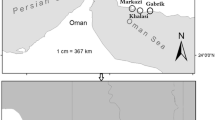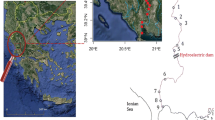Abstract
Río Champotón in the Yucatán Peninsula is within the Usumacinta Province, the most diverse in fish fauna in Mexico, and is part of the Mesoamerican hotspot, with high endemism and exceptional habitat loss. The spatial and seasonal variability of its fish fauna and their relation to physical habitat characteristics were studied, finding 53 taxa. Canonical correspondence analysis shows salinity, distance from the river mouth, and substratum type differentiate an estuarine and a freshwater region. Fish fauna replacement was observed, with taxa exclusive to each region: 26 estuarine and 27 freshwater species. Six freshwater species enter the estuarine region when the high river flow depletes salinity. Estuary showed greater seasonal differences in specific richness than the freshwater region, which have sites with higher local specific richness. Despite its small drainage, Río Champotón has a highly diverse fish fauna and some areas are affected by human activity and the hurricane season. Its conservation is of critical importance.






Similar content being viewed by others
References
Angermeier PL, Karr JR (1983) Fish communities along environmental gradients in a system of tropical streams. Environ Biol Fishes 9:117–135. doi:10.1007/BF00690857
Angermeier PL, Karr JR (1984) Relationships between woody debris and fish habitat in a small warm water stream. Trans Am Fish Soc 113:716–726. doi :10.1577/1548-8659(1984)113<716:RBWDAF>2.0.CO;2
APHA (American Public Health Asociation) (1985) Standard methods: for the examination of water and wastewater. APHA, AWWA, WPCF, Washington, DC, 1268 p
Arriaga L, Aguilar V, Alcocer D, Jiménez R, Muñoz L, Vázquez D (1998) Regiones hidrológicas prioritarias. Escala: 1:4000,000. 2ª. edición. Comisión Nacional para el Conocimiento y Uso de la Biodiversidad, México
Back W (1985) Hydrogeology of the Yucatan. In: Swinehart J, Loope D (eds) Yucatán 1990 a source book on coastal Quintana Roo. Mexico. Univ. Nebraska, Lincoln, pp 25–40
Barletta M, Barletta-Bergan A, Saint-Paul U, Hubold G (2005) The role of salinity in structuring the fish assemblages in a tropical estuary. J Fish Biol 66:45–72. doi:10.1111/j.0022-1112.2005.00582.x
Bezaury CJE, Waller R, Sotomayor L, Li X, Anderson S, Sayre R et al (2000) Conservation of biodiversity in Mexico: ecoregions, sites and conservation targets. The Nature Conservancy, Mexico Division, 122 p
Castro-Aguirre JL (1978) Catálogo sistemático de los peces marinos que penetran a las aguas continentales de México con aspectos zoogeográficos y ecológicos. Inst Nac Pesca Ser Cient 19:1–298
Castro-Aguirre JL, Espinosa-Pérez H, Schmitter-Soto JJ (1999) Ictiofauna estuarino-lagunar y vicaria de México., Editorial Limusa S.A. de C.V. 629 p
Churchill JH, Forward RB, Luettich RA, Hench JL, Hettler WF, Crowder LB et al (1999) Circulation and larval fish transport within a tidally dominated estuary. Fish Oceanogr 8:173–189. doi:10.1046/j.1365-2419.1999.00025.x
CNA (Comisión Nacional del Agua) (1998) Cuencas Hidrológicas. Escala 1:250,000. México
CONABIO (Comisión Nacional para el Conocimiento y Uso de la Biodiversidad) (1999) Uso de suelo y vegetación modificado por CONABIO. Escala 1:1,000,000. Comisión Nacional para el Conocimiento y Uso de la Biodiversidad. Ciudad de México, México
CONABIO (Comisión Nacional para el Conocimiento y Uso de la Biodiversidad) (2002) Lista de regiones hidrológicas prioritarias. http://www.conabio.gob.mx/conocimiento/regionalizacion/doctos/Hlistado.html. Accessed 10 March 2008
Edds DR (1993) Fish assemblage structure and environmental correlates in Nepal’s Gandaki River. Copeia 1:48–60. doi:10.2307/1446294
Hubbs CL (1936) Fishes of the Yucatan Peninsula. In: Pearse AS, Creaser EP, Hall FG (eds) The Cenotes of Yucatan. A zoological and hydrographyc survey. Carnegie Institution of Washington, Publication No. 457, Washington, pp 157–287
Krebs CJ (1989) Ecological methodology. Harper and Row Publishers, New York, 654 p
López-Ramos E (1975) Geological summary of the Yucatán Peninsula. In: Narin AEM, Sthelí FG (eds) The ocean basin and margins, vol 3. Plenum Press, London, pp 257–282
López-López E, Paulo-Maya J (2001) Changes in fish assemblages in the upper rio Ameca, México. J Freshwat Ecol 16(2):179–187
Matthews WJ (1998) Patterns in freshwater fish ecology. Chapman and Hall, New York
Miller RR (1986) Composition and derivation of the freshwater fish fauna of México. An esc nac cienc biol Méx 30:121–153
Miller RR, Minckley WL, Norris SM (2005) Freshwater fishes of México. University of Michigan, Museum of Zoology, Chicago, pp 63–404
Minckley WL, Miller RR, Barbour CD, Schmitter-Soto JJ, Norris SM (2005) Historical Ichthyogeography. In: Miller RR, Minckley WL, Norris SM (eds) Freshwaters fishes of México. Museum of Zoology, Chicago, pp 24–47
Myers N, Russell A, Mittermeier CG, Mittermeier da Fonseca GAB, Kent J (2000) Biodiversity hotspots for conservation priorities. Nature 403:853–858. doi:10.1038/35002501
Naiman RJ, Latterell JJ (2005) Principles for linking fish habitat to fisheries management and conservation. J Fish Biol 67(Suppl B):166–185. doi:10.1111/j.0022-1112.2005.00921.x
NOM (Norma Oficial Mexicana) (2002) Mexican Official regulation NOM-059-ECOL that determine the wild flora, fauna and aquatic species and subspeciesin extintion risk, threatened and rare species and species subject of special protection and that establish the protection specifications. March 6, Mexico City
Oberdorff T, Guilbert E, Lucchetta JC (1993) Patterns of fish species richness in the Seine River basin, France. Hydrobiologia 259:157–167. doi:10.1007/BF00006595
Ortiz-Lozano L, Granados-Barba A, Solís-Weiss V, García-Salgado MA (2005) Environmental evaluation and development problems of the Mexican Coastal Zone. Ocean Coast Manage 48(2):161–176. doi:10.1016/j.ocecoaman.2005.03.001
Pegg MA, McClelland MA (2004) Spatial and temporal patterns in fish communities along the Illinois River. Ecol Freshwat Fish 13:125–135. doi:10.1111/j.1600-0633.2004.00046.x
Rice JC (2005) Understanding fish habitat ecology to achieve conservation. J Fish Biol 67(Suppl B):1–22. doi:10.1111/j.0022-1112.2005.00933.x
Rodiles-Hernández R, Hendrickson D, Lundenberg JG, Humphries J (2005) Lacantunia enigmatica (Teleostei: Siluriformes) a new and phylogenetically puzzling freshwater fish from Mesoamerica. Zootaxa 1000:1–24
Rondon-Súarez Y, Petrere MJ (2007) Environmental factors predicting fish community structure in two neotropical rivers in Brazil. Neotrop Ichthyol 5(1):61–68. doi:10.1590/S1679-62252007000100008
Schlosser I (1982) Fish community structure and function along two habitat gradients in a headwater stream. Ecol Monogr 52:395–414. doi:10.2307/2937352
SMN (Servicio Meterológico Nacional) (2007) Normales climatológicas provisionales periodo 1971–2000. Consultado el 5 de febrero de 2008. http://smn.cna.gob.mx/productos. Accessed February 5 2008
Soto-Galera E, Díaz-Pardo E, López-López E (1998) Fishes as indicators of environmental quality in the Río Lerma Basin. Aquat Ecosyst Health Manage (3–4):267–276. doi:10.1016/S1463-4988(98)00012-8
Sosa-López A, Mouillot D, Ramos-Miranda J, Flores-Hernandez D, Do Chi T (2007) Fish species richness decreases with salinity in tropical coastal lagoons. J Biogeogr 34:52–61. doi:10.1111/j.1365-2699.2006.01588.x
Soto-Galera E, Paulo J, López-López E, Serna-Hernández JA, Lyons J (1999) Change in Fish fauna as indicator of aquatic ecosystem condition in Río Grande de Morelia-Lago de Cuitzeo, Basin, México. Environ Manage 24(1):133–140. doi:10.1007/s002679900221
Tamayo JL (1999) Geografía moderna de México. Trillas, México, 168 p
Vega-Cendejas ME, Hernández M (2004) Fish community structure and dynamics in a coastal hypersaline lagoon: Rio Lagartos, Yucatan, Mexico. Estuar Coast Shelf Sci 60:285–299. doi:10.1016/j.ecss.2004.01.005
XLSTAT (2007) Statistical software for MS Excel. Ver. 2007.5
Yáñez-Arancibia AF, Amezcua L, Tapia M (1981) Prospección ictioecológica del estuario del Rio Champotón, Campeche, Verano de 1979. An Inst Cienc Mar Limnol Univ Nal Auton Mex 9(1):395–398
Whitfield AK, Harrison TD (2003) River flow and fish abundance in a South African estuary. J Fish Biol 62:1467–1472. doi:10.1046/j.1095-8649.2003.00125.x
Acknowledgments
This paper was financed by the Joint Fund of the National Science and Technology Council (CONACyT-Mexico) and the Campeche state government (Project 31173) as well as by the Research and Postgraduate Studies Secretariat (SIP) of the National Polytechnic Institute (IPN-Mexico).
Author information
Authors and Affiliations
Corresponding author
Appendix
Appendix
Code of abbreviations of species in the CCA biplot
Species | Code |
|---|---|
Harengula jaguana | Hare |
Opisthonema oglinum | Opis |
Anchoa mitchilli | Anch |
Astyanax aeneus | Asty |
Rhamdia guatemalensis | Rham |
Synodus foetens | Syno |
Agonostomus monticola | Agon |
Mugil cephalus | Mugi |
Atherinella alvarezi | Athe |
Strongylura timucu | Stro |
Strongylura notata | Stro n |
Chriodorus atherinoides | Chir |
Hyporhamphus roberti hildebrandi | Hypo |
Floridichthys polyommus | Flor |
Belonesox belizanus | Belo |
Carlhubbsia kidderi | Carl |
Gambusia sexradiata | GamS |
Gambusia yucatana | GamY |
Heterandria bimaculata | Hete |
Poecilia mexicana | PoeM |
Poecilia petenensis | PoeP |
Xiphophorus maculatus | Xiph |
Ophisternon aenigmaticum | Ophi |
Centropomus undecimalis | Cent |
Oligoplites saurus | Olig |
Hemicaranx amblyrhynchus | Hemi |
Trachinotus falcatus | Trac |
Lutjanus griseus | Lutj |
Lobotes surinamensis | Lobo |
Eucinostomus gula | EucG |
Eucinostomus jonesii | EucJ |
Gerres cinereus | Gerr |
Archosargus rhomboidalis | Archos |
Haemulon bonariense | HaeB |
Haemulon flavolineatum | HaeF |
Oreochromis sp. | Oreo |
Amphilophus robertsoni | Amph |
Cichlasoma urophthalmus | CicU |
Cichlasoma salvini | CicS |
Petenia splendida | Pete |
Rocio octofasciatus | Arch |
Thorichthys helleri | ThoH |
Thorichthys meeki | ThoM |
Vieja intermedia | VieI |
Vieja heterospila | VieH |
Vieja synspila | VieS |
Vieja sp. | VieSP |
Bathygobius soporator | Bath |
Gobiosoma bosc | Gobi |
Trichiurus lepturus | Tric |
Scomberomorus regalis | Scom |
Achirus lineatus | Achi |
Sphoeroides testudineus | Spho |
Rights and permissions
About this article
Cite this article
López-López, E., Elías Sedeño-Díaz, J., Romero, F.L. et al. Spatial and seasonal distribution patterns of fish assemblages in the Río Champotón, southeastern Mexico. Rev Fish Biol Fisheries 19, 127–142 (2009). https://doi.org/10.1007/s11160-008-9093-y
Received:
Accepted:
Published:
Issue Date:
DOI: https://doi.org/10.1007/s11160-008-9093-y




